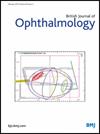Risk factors for macular complications in large solitary peripheral retinal capillary haemangiomas: a multimodal imaging study.
IF 3.5
2区 医学
Q1 OPHTHALMOLOGY
引用次数: 0
Abstract
PURPOSE To characterise the clinical and multimodal imaging features of large solitary peripheral retinal capillary haemangiomas (RCHs) and identify risk factors for distinct macular complications. METHODS In this cross-sectional study, eyes with a large (>1.5 mm) solitary peripheral RCH were included and stratified into three groups according to macular status: RCH with macular sparing (RCH-MS), with macular exudation (RCH-ME) and with macular traction (RCH-MT). Demographic, clinical and multimodal imaging data were collected and compared. Univariable and multivariable regression analyses were performed to assess risk factors. RESULTS Among 69 eyes, 16 were classified as RCH-MS, 33 as RCH-ME and 20 as RCH-MT. Compared with RCH-MS, RCH-ME and RCH-MT exhibited significantly worse visual acuity. Multivariable analysis revealed that RCH-MT was associated with greater tumour-to-foveola distance (OR 1.347, 95% CI 1.024 to 1.771) and higher prevalence of fibrovascular proliferation overlying the RCH (OR 14.371, 95% CI 1.622 to 127.301). Feeding artery dilation was significantly associated with RCH-ME (OR 17.392, 95% CI 2.121 to 142.627) and worse visual acuity (β=0.374, 95% CI 0.023 to 0.724). Feeding artery beading was inversely associated with RCH-ME (OR 0.057, 95% CI 0.006 to 0.552) and correlated with better visual outcome (β=-0.472, 95% CI -0.894 to -0.051). CONCLUSIONS The macular status of large solitary peripheral RCHs is influenced by tumour location, fibrovascular proliferation and feeding artery characteristics. These findings highlight the predictive value of multimodal imaging for macular involvement and visual outcomes and provide insights into the mechanisms underlying RCH-associated macular exudation and traction.大孤立性视网膜周围毛细血管瘤黄斑并发症的危险因素:一项多模式成像研究。
目的探讨大孤立性视网膜周围毛细血管瘤(RCHs)的临床和多模态影像学特征,并确定不同黄斑并发症的危险因素。方法采用横断面研究方法,选取具有较大(>1.5 mm)孤立性外周RCH的眼,根据黄斑状况将其分为3组:黄斑保留型RCH (RCH- ms)、黄斑渗出型RCH (RCH- me)和黄斑牵引型RCH (RCH- mt)。收集并比较了人口学、临床和多模态影像资料。采用单变量和多变量回归分析评估危险因素。结果69只眼中RCH-MS 16只,RCH-ME 33只,RCH-MT 20只。与RCH-MS相比,RCH-ME和RCH-MT的视力明显差。多变量分析显示,RCH- mt与较大的肿瘤到中央窝的距离(OR为1.347,95% CI为1.024至1.771)和较高的RCH上纤维血管增殖发生率相关(OR为14.371,95% CI为1.622至127.301)。供血动脉扩张与RCH-ME (OR为17.392,95% CI为2.121 ~ 142.627)和视力下降显著相关(β=0.374, 95% CI为0.023 ~ 0.724)。供血动脉结块与RCH-ME呈负相关(OR 0.057, 95% CI 0.006 ~ 0.552),与较好的视觉效果相关(β=-0.472, 95% CI -0.894 ~ -0.051)。结论大孤立性外周RCHs的黄斑状况受肿瘤位置、纤维血管增殖和供血动脉特征的影响。这些发现强调了多模态成像对黄斑受累和视觉结果的预测价值,并为rch相关黄斑渗出和牵拉的机制提供了见解。
本文章由计算机程序翻译,如有差异,请以英文原文为准。
求助全文
约1分钟内获得全文
求助全文
来源期刊
CiteScore
10.30
自引率
2.40%
发文量
213
审稿时长
3-6 weeks
期刊介绍:
The British Journal of Ophthalmology (BJO) is an international peer-reviewed journal for ophthalmologists and visual science specialists. BJO publishes clinical investigations, clinical observations, and clinically relevant laboratory investigations related to ophthalmology. It also provides major reviews and also publishes manuscripts covering regional issues in a global context.

 求助内容:
求助内容: 应助结果提醒方式:
应助结果提醒方式:


